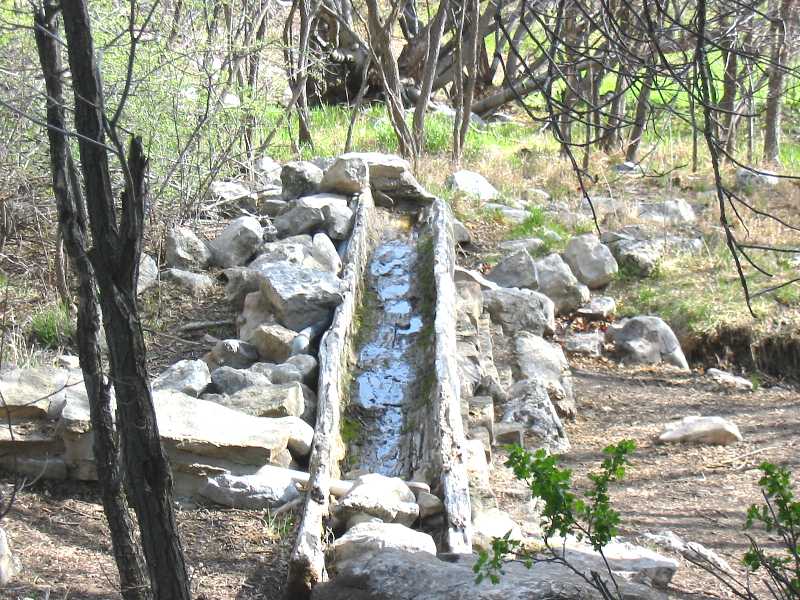
(Click on photo for larger view)
There is a special place at 8600 feet elevation in the Sandia Mountains just east of Albuquerque. I took the above photo one morning in early May of 2003. Sunlight dappled through the leaves of the large Rocky Mountain Maples that thrived in the moist runoff of Capulin Spring. Water from the spring flowed through a pipe and was diverted into a trough formed by an ancient hollow log. Water is scarce in the mountains, and the “Bird Log,” as it is called, attracts most of the creatures that call the mountain their home. One needs only find a comfortable place to sit and simply wait for the birds to come in to drink and bathe.
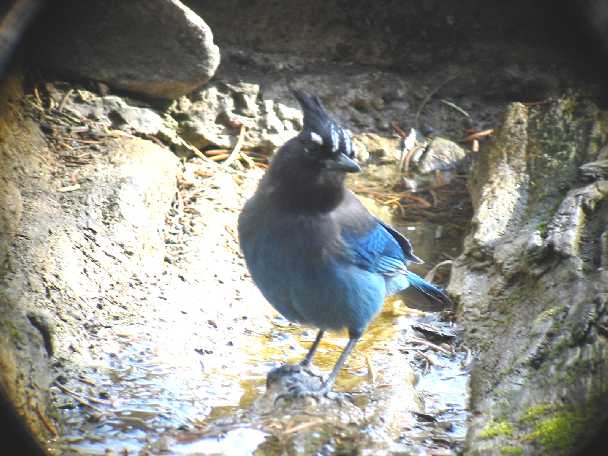 The log is especially popular with birds and birders during spring and fall migration. Even when we arrived early, we often found fellow birders already set up with cushions and binoculars. Birders sometimes gain a sense of “ownership” of such a special place, forgetting that the National Forest actually belongs to everyone. One day a young lady bushwhacked up the hill to the log and propped her back against the log to write (poetry or a love letter?) and enjoy the sounds and sights of nature. She was seemingly unaware of our presence or that she had interrupted our viewing of Western Tanagers, Black-headed Grosbeaks and an assortment of warblers and woodpeckers. Like the thirsty birds, we had to wait for her departure or simply find better hunting grounds.
The log is especially popular with birds and birders during spring and fall migration. Even when we arrived early, we often found fellow birders already set up with cushions and binoculars. Birders sometimes gain a sense of “ownership” of such a special place, forgetting that the National Forest actually belongs to everyone. One day a young lady bushwhacked up the hill to the log and propped her back against the log to write (poetry or a love letter?) and enjoy the sounds and sights of nature. She was seemingly unaware of our presence or that she had interrupted our viewing of Western Tanagers, Black-headed Grosbeaks and an assortment of warblers and woodpeckers. Like the thirsty birds, we had to wait for her departure or simply find better hunting grounds.
During the past several years, the health of the forest has been threatened by drought, disease and insect infestation. Piñon Pines had already been decimated by the bark beetle epidemic, and now death and destruction has spread up the mountain to the White Pines and Douglas-firs. Adding to the damage produced by broom rust, root rot and chewing, sucking and boring insects, the unusually severe winter of 2006-7 produced a heavy snow load and high winds. The task of clearing the fallen and damaged trees far exceeded the staff capabilities of the US Forest Service. Sandia Ranger District volunteers and members of the Friends of the Sandia Mountains are still working hard to clear fallen trees and minimize hazards. Sally Lowder kindly provided the following three photos. The first, taken on May 8, 2007, shows that the area around the Bird Log was not spared:
Happily, the log itself was not damaged by any fallen trees or limbs, but the majestic old maple trees were devastated. The log was in full sunlight as cleanup progressed:. Note the male Western Tanager on the rim:
Nature has wondrous healing powers, and birders were pleased to see how rapidly the saplings invaded the area. Shoots from the old Rocky Mountain Maple that shaded the log (its stump can be seen behind the log in the photo below) are reaching skyward. 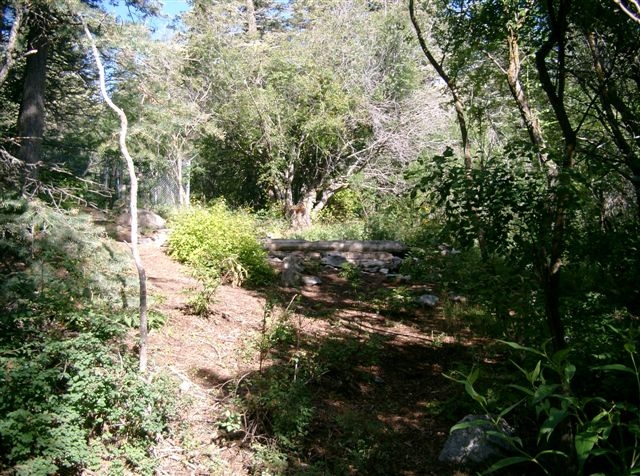
For more about “The Log” and directions follow this link:
http://www.rosyfinch.com/sandia.html#THE_LOG_AT_CAPULIN_SPRING













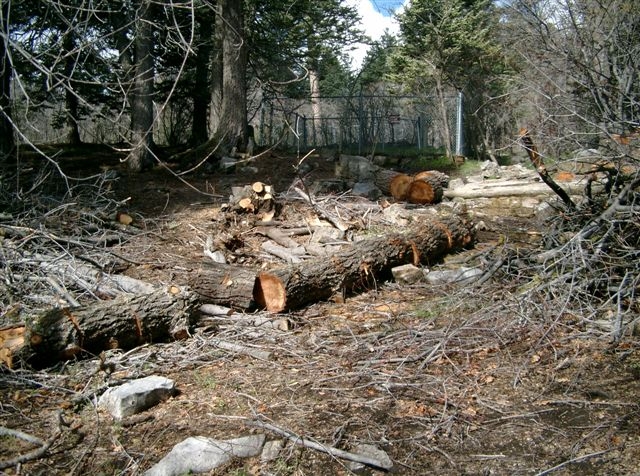
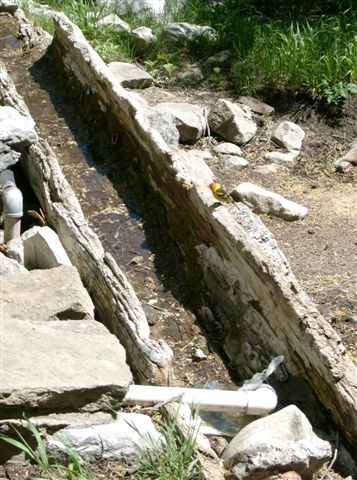
August 6th, 2007 at 5:09 pm Ken, The Thursday Birders will be visiting the log this week. I have not been since Memorial Day weekend, so was pleased to see how much the new growth has sprung up! Judy
August 12th, 2007 at 7:53 am Thanks, Judy. Readers may view the report of your visit in your Blog at: http://wingandsong.wordpress.com/2007/08/10/summer-birds-at-capulin-springs/ Ken
December 3rd, 2007 at 9:15 am Melissa, a US Forest Service volunteer sent me this e-mail with some encouraging news (November 23, 2007): “Hi, Mary Lou and Ken! I’m sure you have been told by now that the Cienega trail has been repaired and that access is part of the plan to renovate the Capulin area. From what I can gather, birders are happy with the plan. Don’t know if the Forest Service has money for the project…”
December 4th, 2007 at 9:19 pm The US Forest Service has proposed alternative plans and a comprehensive environmental assessment for construction around the Capulin Spring “Bird Log” in Cibola National Forest. Three alternatives are proposed. Both #1 and #2 would relocate the main entrance to the Spring and Snowplay area in the interest of highway safety. Both would replace the deteriorating log with a new one from a local tree. Both alternatives #1 and 2 would also improve the bird observation area above the spring by removing the picnic table and fire pit, replacing them with benches for comfortable and ideal observation of the log and birds. Alternative #1 would improve the roadways and parking/ picnic/ gathering facilities, but also attract many more visitors to this pristine area. Alternative #2 would close the entire roadway below the one-way road gate to vehicular traffic. Alternative #3 is actually to do nothing. The proposals and detailed maps are available at: http://www.fs.fed.us/r3/cibola/projects/nepa_reports.shtml Alternative #1 offers great improvements in access for the general public and the handicapped,while #2 provides less disturbance for birds and birders, yet would pose a problem accessing the log viewing area for those with limited mobility. Both would replace the log with a new one and improve the bird viewing area. I encourage birders who are familiar with this site to give the proposal thoughtful review and comment before the December 12 deadline. E-mail comments will be accepted. I understand that all this is contingent upon the Forest District obtaining funds in a difficult environment.
December 7th, 2007 at 6:59 am Several readers contacted me because they could not identify the position of the “Bird Log” on the maps that link to the Forest Service page. Further, I wish to briefly summarize the three proposed alternatives in hopes that this stimulates other birders to provide comments before the December 12 (extended) deadline. Address comments to Eloyce Promenschenkel, Natural Resource Specialist. For questions and more information, please contact Eloyce at 505-281-3304, ext. 112, or epromenschenkel@fs.fed.us. The Capulin Spring “Bird Log” is not identified on the diagrams or in the legends, but on both Figures 1 and 3 there is a faint gray line due north of the area marked #7 that appears to be the position of the log. It is also on Figure 5 (Alternative 3, the “no action” alternative) which shows it, sequentially in line with the square cable rail enclosure and the trapezoidal chain link enclosure (which has the pump for the water line that runs down to the southeast from the spring itself). The picnic table in the present viewing area is south of the log, and the other picnic table downhill from the log is northwest of the terminal loop in the present road. Note that under Alternative 2 (Figure 3), the entire lower road beyond the one-way gate will become a walking path, and the parking area then nearest the log would be in the picnic site identified as #5 in Figure 3. Getting to the log would be a bit of a walk downhill and uphill, not wheelchair accessible. Alternative 1 would improve the existing parking site at the bird log viewing area– it now barely fits 2 cars. Presently, when the gate to the lower road is closed (as it is most of the winter), the nearest place to park is the parking area on the main entrance road to the snow play area just before the double gate, uphill and northeast of the proposed group site marked #4 in the map of Alternative 1. This requires one to scramble sharply downhill off-trail for about 30 yards before picking up the existing trail to the log. Here are my comments: I support relocating the entrance and rehabilitating the log and improving the “bird log” viewing area by removing the picnic facilities (area #7) and installing viewing benches, as proposed in both Alternatives 1 & 2. The new wildlife drinker (”bird log”) should be oriented the same way as presently, so that there is a good line of sight along the length of the log from the viewing area. The original log held up well over the years– I would not expect a pine log to last very long– It was very large in diameter, larger than most local trees. Is it a Douglas-fir or other species? I have mixed feelings of sympathy for birders with limited mobility, versus welcoming more of the “Frisbee” crowd by increasing the number of picnic sites in the immediate area, but I do not favor one alternative over the other. However, if Alternative 1 is chosen, I have some suggestions that may benefit both the birds and birders. (1) The parking place(s) at the bird log viewing area (#7) should be reserved for handicapped visitors only. (2) I am pleased that Alternative 1 terminates the paved road short of the outlet to the existing loop, but would be happier if the USFS just eliminated the picnic area at the north end of the loop (#10 in Alt 1 Fig 1), which is quite close the “bird log.” The water from the log often streams down near that table and there can be good wildlife watching all the way down to the loop (and in wet years, into the cienega below and to the northeast). More than once we have had noisy parties going on there, even in the morning! Rather than a picnic table and fire pit, I suggest that benches be placed there as well. (3) Another improvement I would like to see is to somehow make the log itself “off-limits” to people who may wish to sit against it or even wade in it and the outflow stream, oblivious to birders who may have gotten there first and kept their distance. This could be done aesthetically with a low rail fence, along with appropriate signage. An interpretive sign at the entrance to Area 7 could further explain the need for such a restriction.
March 17th, 2008 at 9:21 am The US Forest Service has chosen Alternative #2, and funds are likely to be made available. Thanks to all of you who provided valuable input to the Sandia Ranger District!
We also learned that providing parking spaces for the handicapped at the pull-in above the log would have required extensive grading. The chosen alternative appears to be responsive to birders’ concerns and will result in increased seclusion for the log and viewing area.
June 11th, 2008 at 2:30 pm It would be nice if the Longitude and Latitude were given for the log, what direstion the new log will point(from end to end)and how much land surface will be plowed under to created this new habitat.
John, see this page in rosyfinch.com for approximate GPS coordinates to several birding spots in the Sandia Mountains.
For Capulin Spring, I show the picnic area to be (approximately, on my Garmin):
Capulin Spring
35° 13.06′N, 106° 24.92′W
The log itself is very close to 35.2178 N / 105.4152 W at 8,834 feet elevation, on Microsoft Live Maps, at this link:
http://maps.live.com/default.aspx?v=2&cp=44.023938~-99.71&style=h&lvl=4&tilt=-89.875918865193&dir=0&alt=7689462.6842358
As for the extent of disturbance, it should be minimal, and vehicular traffic will be excluded. We hope that the US Forest Service responds positively to our suggestion that the orientation of the new log remains the same as at present. Readers are asked to keep me apprised of actual developments.
Thanks for your suggestion!
Ken
July 9th, 2009 at 4:22 pm The Thursday Birders were at The Log this morning. The area is growing back nicely; however, no work appears to have begun on the restoration, except tree removal. Lots of dead trees lying on the ground. The highlight of the day was watching a male Evening Grosbeak feed a juvenile in the tree above where we were sitting.
July 10th, 2009 at 1:35 pm Hi, Judy– Great news about the Evening Grosbeak. I never found them breeding, and some winters they never showed up at all. Did have breeding Red Crossbills in the Ponderosa zone one summer. I hope the log is carefully restored. I worry about the wood they may choose, as pine would rot out in a year. It must be either a hardwood or maybe Douglas Fir. Almost prefer they could find a way to seal it in some kind of epoxy or cement. We put a rubber lining in when all the water was running right out a hole under the pipe, and it conducted the water clear to the end of the log. The present orientation of the log is perfect for viewing. Thanks so much for your commnets! Ken
August 6th, 2010 at 9:05 am Judy Liddell visited the Bird Log last month and reported it in this blog post: http://wingandsong.wordpress.com/2010/07/01/birthday-birding-in-the-sandia-mountains/
April 24th, 2012 at 5:29 pm Ken, The Thursday Birders will be doing clean-up and other tasks on July 5, which hopefully will facilitate re-opening the area for birders.